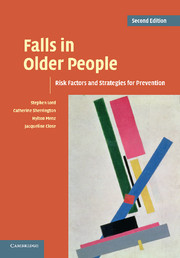Book contents
- Frontmatter
- Contents
- Preface
- Acknowledgements
- Part I Epidemiology and risk factors for falls
- 1 Epidemiology of falls and fall-related injuries
- 2 Postural stability and falls
- 3 Gait characteristics and falls
- 4 Sensory and neuromuscular risk factors for falls
- 5 Psychological factors and falls
- 6 Medical risk factors for falls
- 7 Medications as risk factors for falls
- 8 Environmental risk factors for falls
- 9 The relative importance of falls risk factors: an evidence-based summary
- Part II Strategies for prevention
- Part III Research issues in falls prevention
- Index
- References
4 - Sensory and neuromuscular risk factors for falls
Published online by Cambridge University Press: 03 May 2010
- Frontmatter
- Contents
- Preface
- Acknowledgements
- Part I Epidemiology and risk factors for falls
- 1 Epidemiology of falls and fall-related injuries
- 2 Postural stability and falls
- 3 Gait characteristics and falls
- 4 Sensory and neuromuscular risk factors for falls
- 5 Psychological factors and falls
- 6 Medical risk factors for falls
- 7 Medications as risk factors for falls
- 8 Environmental risk factors for falls
- 9 The relative importance of falls risk factors: an evidence-based summary
- Part II Strategies for prevention
- Part III Research issues in falls prevention
- Index
- References
Summary
As discussed in Chapter 2, human balance depends on the interaction of multiple sensory, motor and integrative systems. In this chapter we review the studies which have dealt with: (i) age-related changes in the sensory and motor factors that are involved in balance control; and (ii) associations between these sensory and motor factors and falls in older people. Specific areas reviewed include: vision; visual field dependence; peripheral sensation; muscle strength, power and endurance; and reaction time.
Age-related changes in sensorimotor function
Figure 4.1 shows the physiological systems that are the primary contributors to stability. Many studies have found that functioning of these sensory, motor and integration systems declines significantly with age, and that impairment in these systems is associated with falls in older people. In fact, researchers have noted many people experience age-related declines in sensorimotor function, even in the absence of any documented disease. We have also found that many older people with a history of falls have no identifiable neurological or musculo-skeletal disease yet perform poorly in tests of sensorimotor function. As shown in Figure 4.2, these people mostly cite trips, slips, loss of balance and muscle weakness as the causes of their falls.
Figure 4.3 shows the ‘normal’ age-related decline in function in a sensorimotor system that contributes to stability. The figure shows that up until age 55 there is little change in function, but beyond this age there is a progressive decline.
- Type
- Chapter
- Information
- Falls in Older PeopleRisk Factors and Strategies for Prevention, pp. 70 - 89Publisher: Cambridge University PressPrint publication year: 2007



